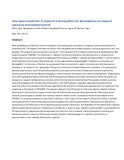How does investment in research training affect the development of research networks and collaborations?

View/
Date
2013-05-20Author
Paina, Ligia
Ssengooba, Freddie
Waswa, Douglas
M’Imunya, James M
Bennett, Sara
Type
Journal ArticleMetadata
Show full item recordAbstract
Abstract
Background
Whether and how research training programs contribute to research network development is underexplored. The Fogarty International Center (FIC) has supported overseas research training programs for over two decades. FIC programs could provide an entry point in the development of research networks and collaborations. We examine whether FIC’s investment in research training contributed to the development of networks and collaborations in two countries with longstanding FIC investments – Uganda and Kenya – and the factors which facilitated this process.
Methods
As part of two case studies at Uganda’s Makerere University and Kenya’s University of Nairobi, we conducted 53 semi-structured in-depth interviews and nine focus group discussions. To expand on our case study findings, we conducted a focused bibliometric analysis on two purposively selected topic areas to examine scientific productivity and used online network illustration tools to examine the resulting network structures.
Results
FIC support made important contributions to network development. Respondents from both Uganda and Kenya confirmed that FIC programs consistently provided trainees with networking skills and exposure to research collaborations, primarily within the institutions implementing FIC programs. In both countries, networks struggled with inclusiveness, particularly in HIV/AIDS research. Ugandan respondents perceived their networks to be more cohesive than Kenyan respondents did. Network cohesiveness was positively correlated with the magnitude and longevity of FIC’s programs. Support from FIC grants to local and regional research network development and networking opportunities, such as conferences, was rare. Synergies between FIC programs and research grants helped to solidify and maintain research collaborations.
Conclusions
Networks developed where FIC’s programs focused on a particular institution, there was a critical mass of trainees with similar interests, and investments for network development were available from early implementation. Networks were less likely to emerge where FIC efforts were thinly scattered across multiple institutions. The availability of complementary research grants created opportunities for researchers to collaborate in grant writing, research implementation, and publications. FIC experiences in Uganda and Kenya showcase the important role of research training programs in creating and sustaining research networks. FIC programs should consider including support to research networks more systematically in their capacity development agenda.
URI
http://dx.doi.org/10.1186/1478-4505-11-18http://erepository.uonbi.ac.ke:8080/xmlui/handle/123456789/28843
